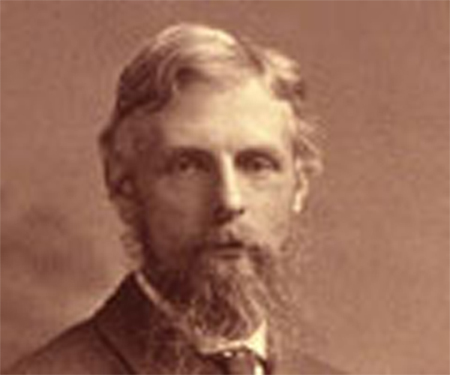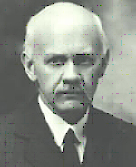Augustus George Vernon Harcourt
Augustus George Vernon Harcourt ( born December 24, 1834 in London, † August 23 1919 in St Clare, at Ryde ) was a British chemist who was among the founders of chemical kinetics. He was - at least partly - a model for the shape of the White Knight in Lewis Carroll's children's book Alice Through the Looking Glass.
Life and work
Family and private life
Augustus George Vernon Harcourt was the elder son of Admiral Frederick Edward Vernon Harcourt (1790-1883) and his wife Marcia († 1868), sister of John Jervis Tollemache, 1st Baron Tollemache ( 1805-1890 ). His grandfather was Edward Harcourt (1757-1847), archbishop of York and his uncle William Vernon Harcourt (1789-1871), considered the founder of the British Association for the Advancement of Science.
Harcourt was closely associated with Charles Dodgson, better known as Lewis Carroll friends. Together they spent a lot of time with the children of Benjamin Collins Brodie and Henry George Liddell, including Alice Liddell. He was - at least partly - a model for the shape of the White Knight in Carroll's children's book Alice Through the Looking Glass.
In 1872 he married Rachel Mary Bruce ( 1848-1927 ), a daughter of Henry Bruce, 1st Baron Aberdare, with whom he had two sons and eight daughters, including Janet Vernon Harcourt ( 1879-1966 ).
Education and professional career
Augustus George Vernon Harcourt was first taught at the Cheam and Harrow School. From 1854 he continued his education at Balliol College, Oxford continues where the mathematician Henry John Stephen Smith was one of his teachers. After Benjamin Collins Brodie Jr. had in 1855 received his teaching career as a Professor of Chemistry, Harcourt soon became his assistant. As Brodie in 1858 moved to the newly founded Oxford University Museum of Natural History, Harcourt succeeded him as lecture assistant. 1859 Harcourt became the Dr- Lee's reader for chemistry, named after Matthew Lee ( 1695-1755 ) and was elected a senior student of Christ Church. He held both positions until 1902 when he retired.
Harcourt taught some later eminent chemists, for example, Harold Baily Dixon (1852-1930), David Leonard Chapman (1869-1958) and Nevil Vincent Sidgwick ( 1873-1952 ).
Research
The early 1860s Harcourt began with the speed of chemical reactions involved. He was looking for reactions in which he could measure the amount of change over a given period exactly. It Harcourt focused on a reaction of oxalic acid, potassium permanganate and sulfuric acid and hydrogen peroxide and hydrogen iodide in between an acidic solution, which turned out to be easier to handle. In collaboration with the mathematician William Esson Harcourt in 1866 could be as independent of Cato Maximilian Guldberg and Peter scale formulate the law of mass action in its simplest form. 1912 both worked together again to determine the influence of temperature on the reaction rate, but were not very successful. However, a remarkable result of this collaboration was the prediction of a temperature at which any chemical reaction would stop. As temperature they gave a value of -272.6 ° C, with the absolute zero (0 K corresponds to -273.15 ° C) pretty good matches.
In the field of applied chemistry Harcourt, who was appointed in 1872 as one of three advisors of the London Metropolitan Gas Works, was busy with studies on the purity of the city gas. For this, he developed a sulfur test. He also invented a pentane lamp that replaced the spermaceti candles previously used as a standard light source for measurements. 1899 Harcourt had developed a method for determining the concentration of chloroform. He became an adviser to the British Medical Association and devised a simple portable inhaler for chloroform anesthesia, which found practical use for some time.
Memberships
Harcourt was admitted to the Chemical Society in 1859. From 1865 to 1873 he was one of their secretaries and 1895 President of the Chemical Society. On June 4, 1868 Harcourt was accepted as a member of the Royal Society. From 1878 to 1880 he worked for the Council of the Society. Together with William Esson he held on May 9, 1895, the Baker - lecture. Early on he took part in the meeting of the British Association and made numerous contributions to the chemical section, which he was president in 1875. Some years later, Harcourt was elected one of the secretaries-general of the British Association. This office he held for 14 years.
Writings (selection )
- Exercises in Practical Chemistry. 1st edition, Clarendon Press, Oxford 1869 (online) with George Henry Madan ( 1838-1901 )
Journal articles
- On the Peroxides of Sodium Potassium and. In: Quarterly Journal of the Chemical Society of London. Volume 14, 1862, p.267 -290 ( doi: 10.1039/QJ8621400267 ).
- On a Method for the Determination of Nitric and Nitrous Acids. In: Quarterly Journal of the Chemical Society of London. Volume 15, 1862, pp. 381-386 ( doi: 10.1039/JS8621500381 ).
- On the rate of chemical change. In: Chemical news and journal of physical science. Volume 10, 1864, pp. 171-173 (online).
- On the Laws of Connexion Between The Conditions of a Chemical Change and Its Amount. In: Proceedings of the Royal Society. Volume 14, 1865, pp. 470-474 ( doi: 10.1098/rspl.1865.0080 ). - With William Esson
- On the Laws of Connexion Between The Conditions of a Chemical Change and Its Amount. In: Philosophical Transactions of the Royal Society. Volume 156, 1866, pp. 193-221 ( doi: 10.1098/rstl.1866.0010 ) - with William Esson
- On the Observation of the course of Chemical Change. In: Journal of the Chemical Society. Volume 20, 1867, pp. 460-492 ( doi: 10.1039/JS8672000460 ).
- On a Continuous Process for Purifying Coal gas from sulphuretted hydrogen and ammonia, and for Extracting Sulphur and ammoniacal Salts. In Chemical news and journal of industrial science. Volume 28, Number 723, 1873, p 175 (online). - With Frederick William Fison, 1st Baronet ( 1847-1927 )
- Bakerian Lecture: On the Laws of Connexion Between The Conditions of Chemical Change and Its Amount. In: Proceedings of the Royal Society. Volume 58, number 347-352, 1895, pp. 108-113 ( doi: 10.1098/rspl.1895.0014 ).
- On a Method for Providing a Current of Gaseous chloroform mixed with air in any Desired proportion, and on Methods for Estimating the chloroform in the Gaseous Mixtures. In: Journal of the Chemical Society, Transactions. Volume 75, 1899, pp. 1060-1066 ( doi: 10.1039/CT8997501060 ).
- Observations on the Phenomena and Products of Decomposition When normal Cupric Acetate is Heated. In: Journal of the Chemical Society, Transactions. Volume 81, 1902, pp. 1385-1402 ( doi: 10.1039/CT9028101385 ). - With Andrea Angel (1877-1917)
- The Oxford Museum and its Founders. In: The Cornhill Magazine. Volume 28, 1910, pp. 350-363 (online).
- A Method for the Estimation of Small Quantities of Approximate Lead. In: Journal of the Chemical Society, Transactions. Volume 97, 1910, pp. 841-845 ( doi: 10.1039/CT9109700841 ).
- The Alleged Complexity of Tellurium. In: Journal of the Chemical Society, Transactions. Volume 99, 1911, pp. 1311-1313 ( doi: 10.1039/CT9119901311 ) - with Herbert Brereton Baker.
- On the Variation with Temperature of the Rate of a Chemical Change. In: Philosophical Transactions of the Royal Society A. Volume 212, number 484-496, 1913, pp. 187-204 ( doi: 10.1098/rsta.1913.0006 ). - With William Esson









